
The Lombards or Longobards were a Germanic people who conquered most of the Italian Peninsula between 568 and 774.

Benevento is a city and comune (municipality) of Campania, Italy, capital of the province of Benevento, 50 kilometres (31 mi) northeast of Naples. It is situated on a hill 130 metres above sea level at the confluence of the Calore Irpino and the Sabato. In 2020, Benevento has 58,418 inhabitants. It is also the seat of a Catholic archbishop.

The Exarchate of Ravenna, also known as the Exarchate of Italy, was an administrative district of the Byzantine Empire comprising, between the 6th and 8th centuries, the territories under the jurisdiction of the exarch of Italy resident in Ravenna. The term is used in historiography in a double sense: "exarchate" in the strict sense denotes the territory under the direct jurisdiction of the exarch, i.e. the area of the capital Ravenna, but the term is mainly used to designate all the Byzantine territories in continental and peninsular Italy. According to the legal sources of the time, these territories constituted the so-called Provincia Italiae, on the basis of the fact that they too, until at least the end of the 7th century, fell under the jurisdiction of the exarch and were governed by duces or magistri militum under him.

The Sanctuary of Saint Michael the Archangel is a Roman Catholic shrine on Mount Gargano, Italy, part of the commune of Monte Sant'Angelo, in the province of Foggia, northern Apulia. It has the dignity of a minor basilica.
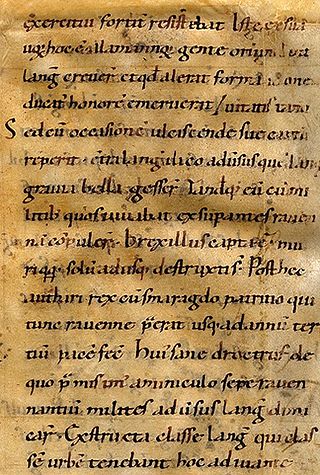
The History of the Lombards or the History of the Langobards is the chief work by Paul the Deacon, written in the late 8th century. This incomplete history in six books was written after 787 and at any rate no later than 796, maybe at Montecassino.

Arechis II was a Duke of Benevento, in Southern Italy. He sought to expand the Beneventos' influence into areas of Italy that were still under Byzantine control, but he also had to defend against Charlemagne, who had conquered northern Italy.
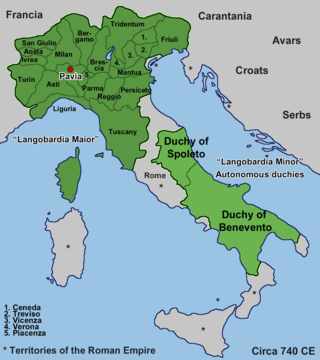
Langobardia Minor was the name that, in the Early Middle Ages, was given to the Lombard domains in central and southern Italy, corresponding to the duchies of Spoleto and Benevento. After the conquest of the Lombard kingdom by Charlemagne in 774, it remained under Lombard control.

The Kingdom of the Lombards, also known as the Lombard Kingdom and later as the Kingdom of all Italy, was an early medieval state established by the Lombards, a Germanic people, on the Italian Peninsula in the latter part of the 6th century. The king was traditionally elected by the very highest-ranking aristocrats, the dukes, as several attempts to establish a hereditary dynasty failed. The kingdom was subdivided into a varying number of duchies, ruled by semi-autonomous dukes, which were in turn subdivided into gastaldates at the municipal level. The capital of the kingdom and the center of its political life was Pavia in the modern northern Italian region of Lombardy.
Andreas of Bergamo was an Italian historian of the late ninth century. He composed a continuation of the Historia Langobardorum of Paul the Deacon down to ca. 877. The short continuation, untitled in the manuscripts, is sometimes called the Andreæ presbyteri Bergomatis chronicon. All that is known of Andreas is that he was a priest of the diocese of Bergamo that he helped carry the coffin of the Emperor Louis II from the river Oglio as far as the Adda in 875. However, he never says that he was from Bergamo and he never identifies himself as either a Lombard or a Frank.
The Emirate of Bari was a short-lived Islamic state in Apulia, in what is now Italy, ruled by non-Arabs, probably Berbers and Black West Africans. Controlled from the South Italian city of Bari, it was established about 847 when the region was taken from the Byzantine Empire, but fell in 871 to the army of the Carolingian emperor Louis II.
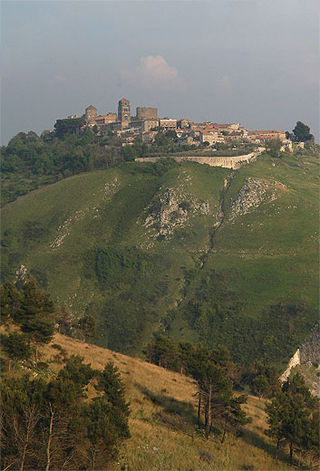
Casertavecchia is a frazione of Caserta, Italy. It is the site of a former medieval village that lies at the foot of the Tifatini Mountains located 10km north-east of the City of Caserta, at an altitude of approximately 401 meters. Its name, translated from Italian, means "Old Caserta".
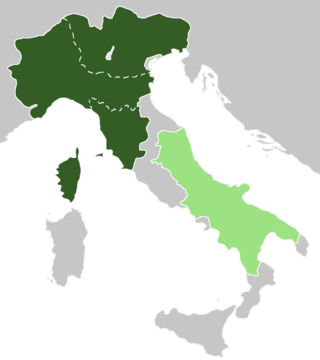
Austria was, according to the early medieval geographical classification, the eastern portion of Langobardia Major, the north-central part of the Lombard Kingdom, extended from the Adda to Friuli and opposite to Neustria. The partition had not only been territorial, but also implied significant cultural and political differences.

Neustria was, according to the early medieval geographical classification, the western portion of Langobardia Major, the north-central part of the Lombard Kingdom, extended from the Adda (river) to the Western Alps and opposite to Austria. The partition had not only been territorial, but also implied significant cultural and political differences.
Among the Lombards, the duke or dux was the man who acted as political and military commander of a set of "military families", irrespective of any territorial appropriation.
The Historia Langobardorum codicis Gothani, also called the Chronicon Gothanum, is a history of the Lombard people written at and for the court of King Pippin of Italy between the years 806 and 810. It is preserved in the 10th/11th century Codex Gothanus 84, from which its conventional Latin titles are derived; The chronicle is not titled in the manuscript. The text is ideologically pro-Carolingian, and among its sources are Isidore of Seville and possibly Jerome.
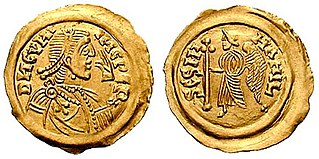
The coinage of the Lombards refers to the autonomous productions of coins by the Lombards. It constitutes part of the coinage produced by Germanic peoples occupying the former territory of the Roman Empire during the Migration Period. All known Lombard coinage was produced after their settlement of Italy. The coinage originates from two distinct areas, in Langobardia Major between the last decades of the sixth century and 774, and in Langobardia Minor, in the duchy of Benevento, between approximately 680 and the end of the 9th century.

The Frankish emperor Louis II campaigned against the Emirate of Bari continuously from 866 until 871. Louis was allied with the Lombard principalities of southern Italy from the start, but an attempt at joint action with the Byzantine Empire failed in 869. In the final siege of the city of Bari in 871, Louis was assisted by a Slavic fleet from across the Adriatic.

The siege of Salerno was one of the campaigns of the Aghlabids in southern Italy during their conquest of Sicily. The Lombard city of Salerno had strong defences and, despite the use of stone-throwing artillery, the siege lasted a little over a year from its beginning in late 871 or early 872. Prince Guaifer of Salerno led the defence, but the siege was only lifted by the arrival of an army of Lombards and Franks under the Emperor Louis II.
Peter I was the bishop of Benevento from 887 or 894 until at least 902. His pontificate was marked by rapid political shifts, with Benevento successively under Byzantine (891–895), Spoletan (895–897) and Lombard rule. Peter was imprisoned and exiled a first time in 895. He served as the regent and de facto ruler of the Principality of Benevento between 897 and 900. In 902, he was proclaimed prince by the people but refused the office and went into exile a second time. He died in 914, possibly still in exile. He was buried in Benevento

The Lombard coinage of Benevento, part of the more general Lombard coinage, is the set of coins minted between about 680 and the end of the ninth century in the duchy and principality of Benevento. Solidi and tremisses, both gold coins that imitated those of the Eastern Roman Empire, were first minted; later followed the issuance of coins in the names first of the dukes and then of the Benevento princes. Toward the end of the 8th century alongside the gold coins were minted silver coins, which gradually took the place of the earlier ones, as moreover happened in the rest of Western Europe. Silver became the prevalent coinage metal only from the mid-9th century.












